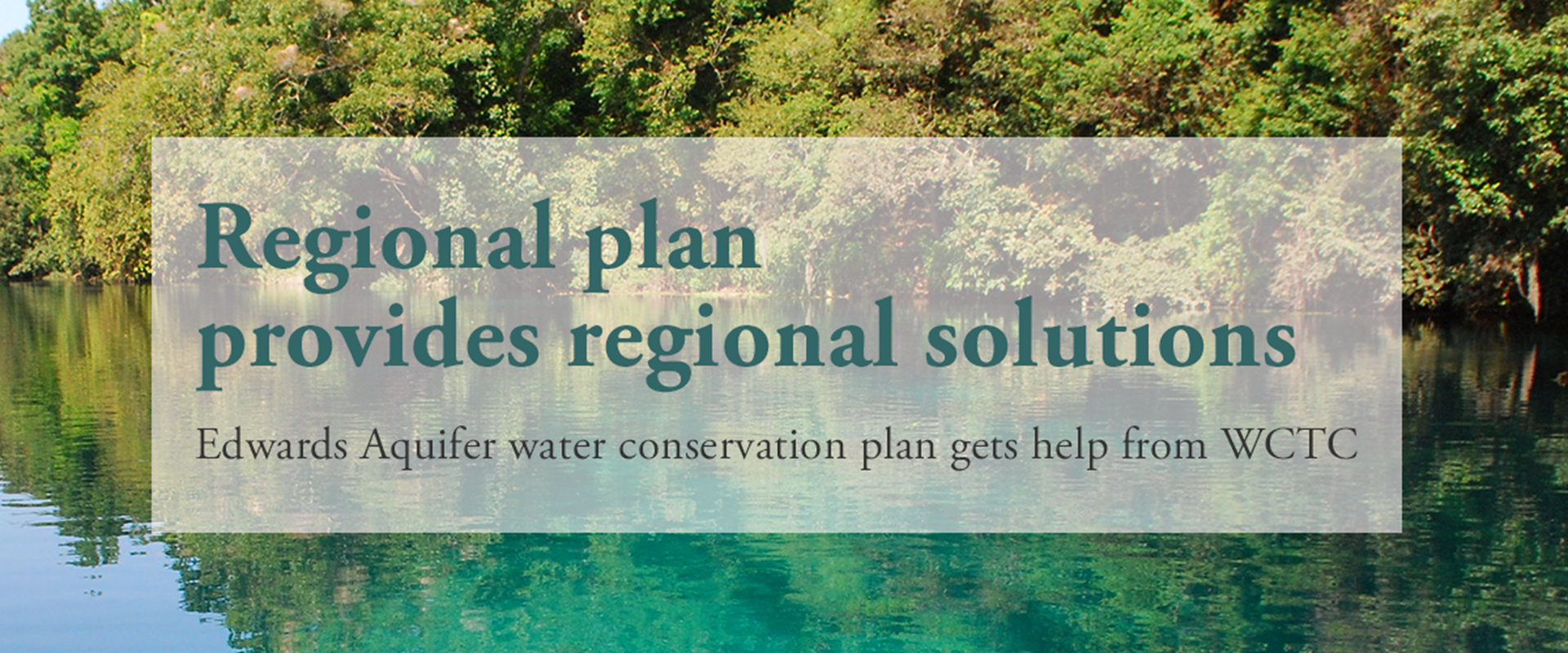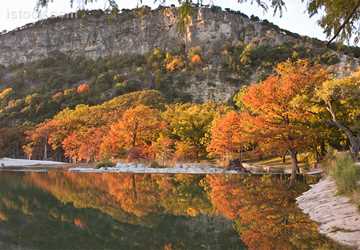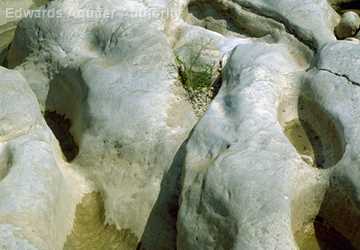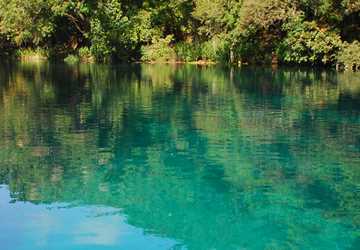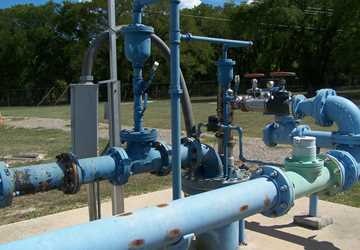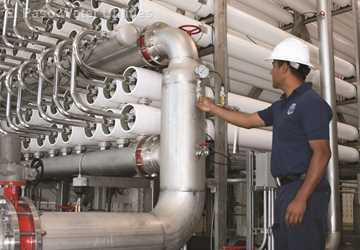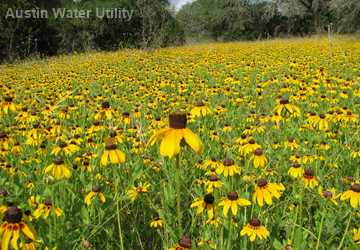By Katie Heinrich
Eight endangered species listings, years of stakeholder negotiations and one federally approved habitat conservation plan later, the Edwards Aquifer Authority (EAA) and its partners are providing stability to water management in the Edwards Aquifer region. The Edwards Aquifer Habitat Conservation Plan (EAHCP) seeks to strike a balance between protecting the endangered species and the ability to provide water from the aquifer for human use. The Water Conservation and Technology Center (WCTC) is helping make sure the plan succeeds.
Along with EAA, the cities of San Antonio through the San Antonio Water System (SAWS), San Marcos and New Braunfels; and Texas State University are leading the implementation of the plan. More than 39 stakeholder groups and individuals, including the Guadalupe-Blanco River Authority and the Texas Parks and Wildlife Department, participated in the Edwards Aquifer Recovery Implementation Program (EARIP), a voluntary initiative that developed the EAHCP. The U.S. Fish and Wildlife Service approved the plan in February 2013.
The eight federally listed endangered species provided for in the plan are the fountain darter, San Marcos salamander, San Marco gambusia, Texas blind salamander, Peck’s cave amphipod, Comal Springs dryopid beetle, Comal Springs riffle beetle and Texas wild rice. These eight species are only known to be found in the Comal and San Marcos springs, which depend directly on water in, or discharged from, the aquifer.
The EAHCP’s first phase includes extensive habitat protection measures to increase the viability of the species at the springs, plus four flow protection activities to provide water flow at the springs.
The Regional Water Conservation Program (RWCP), one of the four flow protection measures, was drafted to provide additional water to the aquifer through conservation activities. The other three flow measures found in phase I include the Voluntary Irrigation Suspension Program Option, the use of SAWS aquifer storage and recovery system, and emergency stage V critical period management deductions.
Contribution of water conservation savings
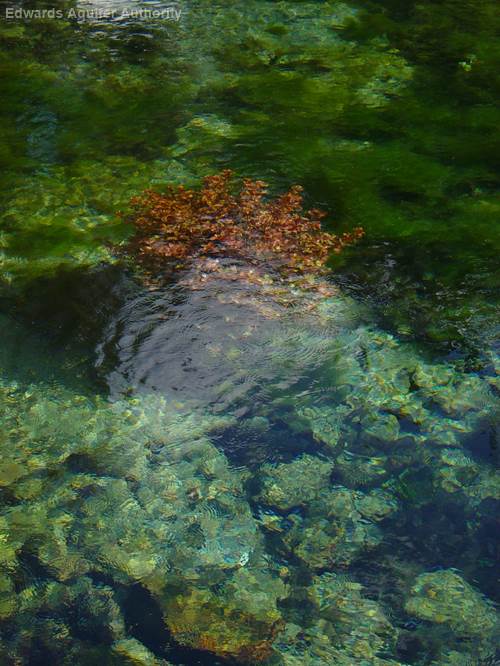
The goal of the water conservation program is to save 20,000 acre-feet of permitted or exempt Edwards Aquifer withdrawals, with 10,000 acre-feet of that savings remaining in the aquifer over the 15-year timespan of the habitat conservation plan. In exchange for technical assistance and incentives for implementing various conservation measures, each participating entity is required to commit that 50 percent of its achieved water savings will remain in the aquifer. To jumpstart the program, San Marcos, along with Texas State University and SAWS, committed to reduce pumping from the aquifer starting in 2011. WCTC Director Dr. Calvin Finch said they have essentially already “loaned” almost 10,000 acre-feet that will stay in the aquifer for 10 years or until newly conserved water can replace it.
WCTC involvement
To support this goal, the aquifer authority selected the center, located in San Antonio and administered by the Texas Water Resources Institute and Texas Center for Applied Technology. Finch said the center is helping develop, coordinate and monitor the expanded conservation plans in small-to-middle-size communities, exempt well owners, schools or hospitals and large water suppliers in the region. Exempt well users are small acreage landowners who pump water directly from the aquifer.
Finch said the expertise of the center’s staff and their long-time involvement in the EARIP process are among the reasons it was selected to help implement the water conservation program. Finch also noted that the center has access to Texas A&M AgriLife Extension Service agents in each county of the region and strives to keep the implementation costs of the plans reasonable for participants.
Water conservation activities
Currently, the center is assisting water users in the region in implementing four water conservation activities outlined in the program: 1) incorporating high-efficiency plumbing, 2) identifying leak repairs, metering problems and other issues that result in lost water, 3) contributing to commercial/industrial technology changes with retrofit rebates, and 4) encouraging water reclamation and reuse, such as graywater, air conditioning condensate and rainwater harvesting.
Research results show that using these toilets saves 12,600 gallons per toilet per year. Conversion to high-efficiency showerheads and aerators has also been shown to save 10,000 gallons per household per year.
Finch said these four activities were chosen because they have been successful when implemented by SAWS and other regional entities, and because it’s easy to monitor water savings.
He said the rebates and other activities will be paid by local water providers to homeowners or industries, and the RWCP will reimburse the providers.
The high-efficiency plumbing activity includes installation of Caroma high-efficiency toilets, designed in Australia. Research results show that using these toilets saves 12,600 gallons per toilet per year. Conversion to high-efficiency showerheads and aerators has also been shown to save 10,000 gallons per household per year, Finch said.
The center will also help smaller water suppliers with surveys of leak detection and lost water as well as implementing improvement plans. RWCP funds include cost-share for water surveys, meter replacements and leak repairs and assistance in identifying additional funding sources for the conversions.
Commercial/industrial users must have a cost and saving analysis performed by their firm’s engineers that will be verified by Texas A&M University System engineers before an incentive is paid. Finch said there is some flexibility on the incentive, but in the program, it is typically $900 per acre-feet of water saved.
Finch said homeowners like the water reclamation and reuse option because of the ease of retrofitting for graywater use. Graywater systems need little infrastructure and save a lot of water, he said. There is a rebate for completing the graywater retrofit, and a small rebate for a rainwater or condensate system with at least 2,000 gallons of storage.
Communities and exempt well owners
The water conservation activities will be used in four program components: a community assessment program for small-to-medium-size communities, a private well owner program, a regionwide school or hospital program and a large water supplier program.
We thought this program would be ideal for those communities, because the program is able to provide funds so they can get access to new water.
Currently, Finch said the criteria for contacting the communities to participate in RWCP activities are based on the amount of water they have jurisdiction over in the aquifer. He said the center will identify and contact at least nine communities who may not have funding or administrative staff to run a communitywide conservation program without the help of the RWCP.
“We thought this program would be ideal for those communities, because the program is able to provide funds so they can get access to new water,” Finch said.
Once a community is contacted, a water conservation assessment will be made. He said the center’s staff will then write a feasible program that meets the community’s conservation opportunities and interests at a reasonable cost and includes one or more of the four water conservation activities.
He said WCTC is already working with several interested and identified communities. The city of Uvalde began its conservation program March 8 by distributing high-efficiency toilets and offering industrial/commercial rebates as well as reuse incentives for both municipal and exempt water users. Universal City will be the next to follow in implementing a plan.
Finch said exempt well users are also a viable target for the RWCP. AgriLife Extension has a working relationship with private well owners and Finch hopes that with help from AgriLife Extension agents, the program can get more participation from these well owners in the region.
Finch likewise expects to use the four conservation activities in a regionwide conservation program, working with a large water user group such as schools, hospitals, restaurants or hotels.
By reaching out to communities in a five-county aquifer region — Hays, Comal, Bayer, Medina and Uvalde counties, Finch said WCTC is contributing to the goals of the habitat conservation plan by giving smaller communities and exempt well owners the opportunity to participate and contribute.
Moving forward
Overall, the cost of implementing the EAHCP is more than $18 million a year for 15 years and will be funded mainly through an aquifer management fee increase. Of that $18 million, the water conservation program will cost $1.9 million a year.
Finch said one of the crucial parts of the habitat conservation plan is that it is individualized and flexible. “A key part of EAHCP is the adaptive management provision. If parts do not work, there will be an evaluation of all of the activities included in the conservation program,” he said. “The EAA, the implementing group and other stakeholders will look to see if their goals are being accomplished and if the program overall is where it is intended to be.
“The impacts of the activities and the effect of the spring flow on the endangered species will be closely monitored so that action can be taken to revise goals and/or activities to better protect the species as the program proceeds.”

